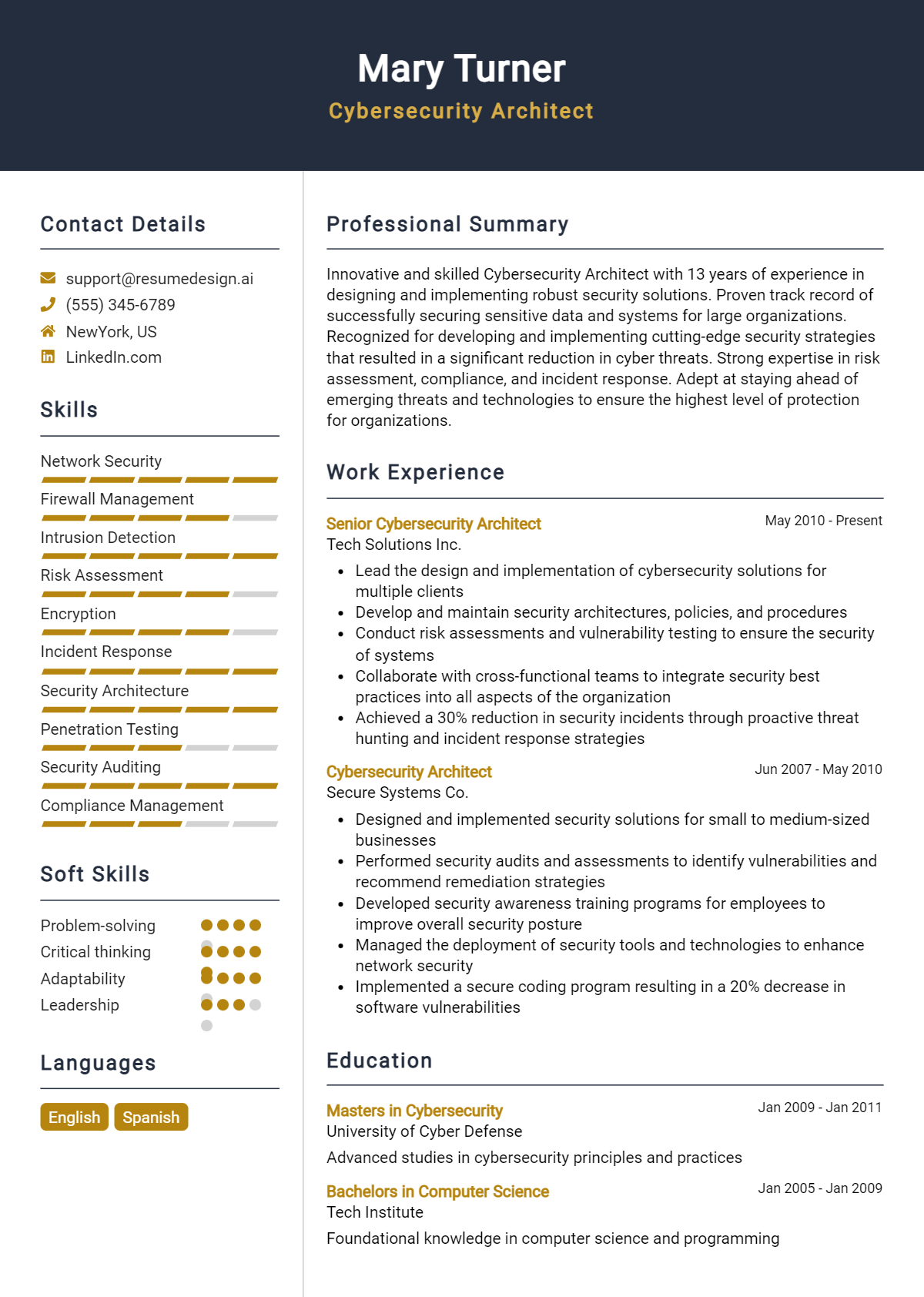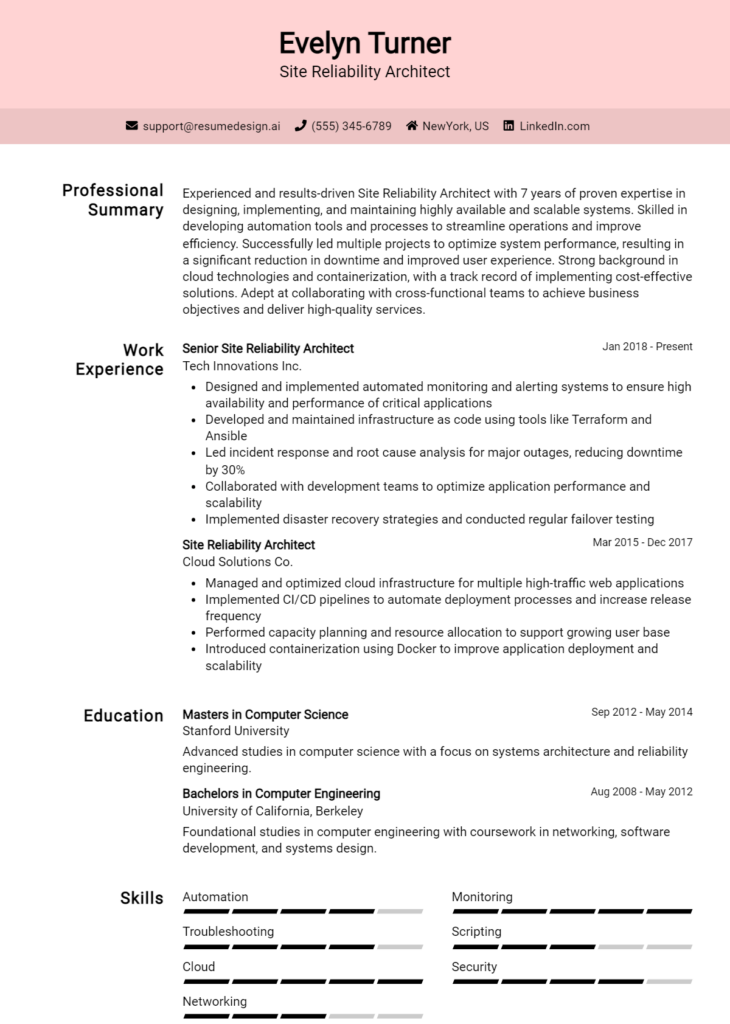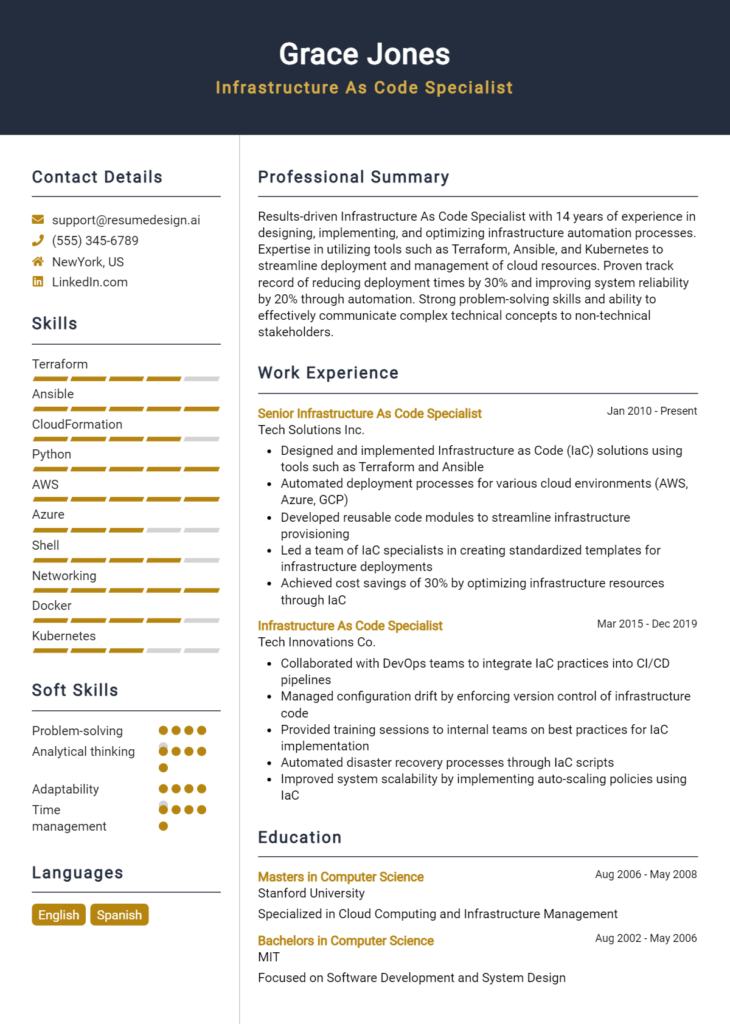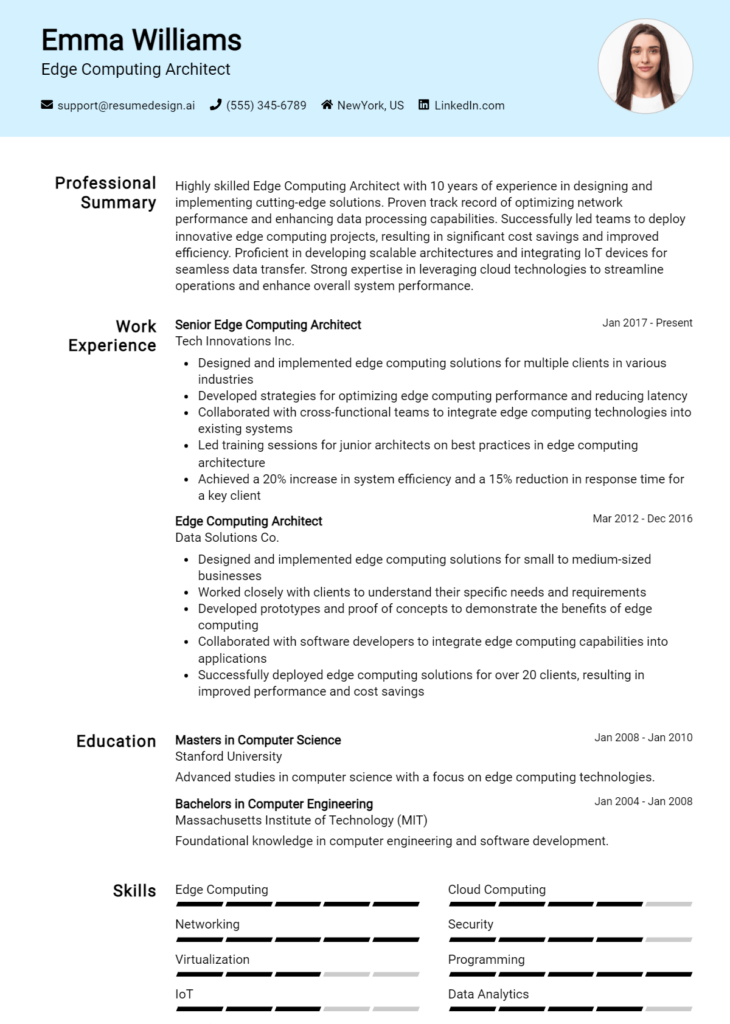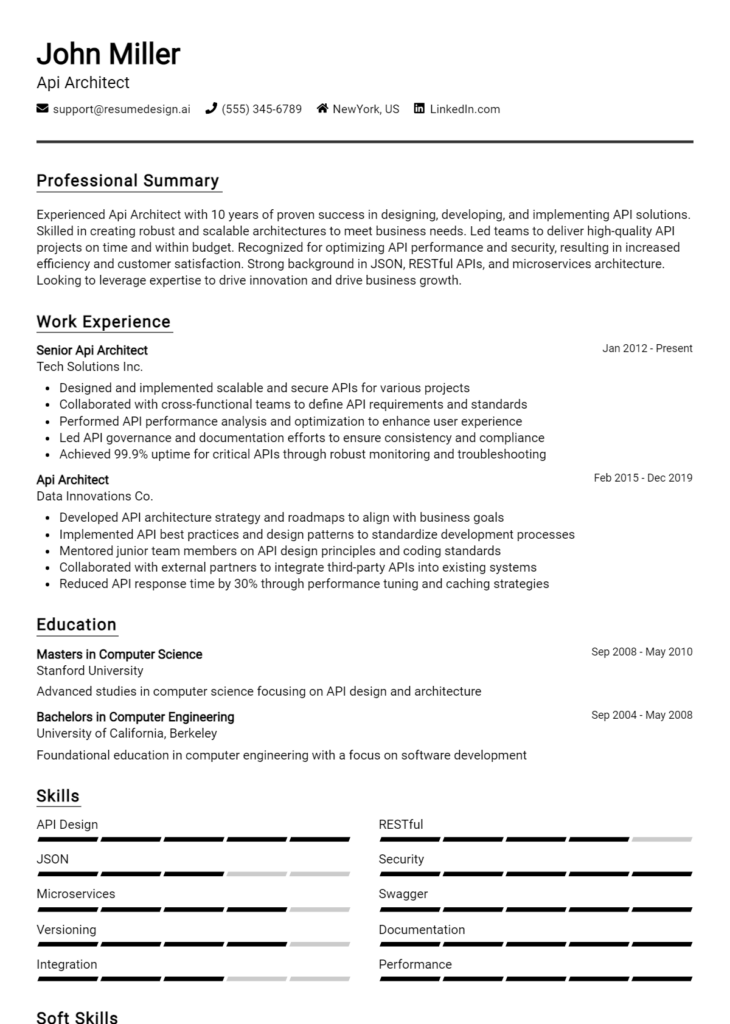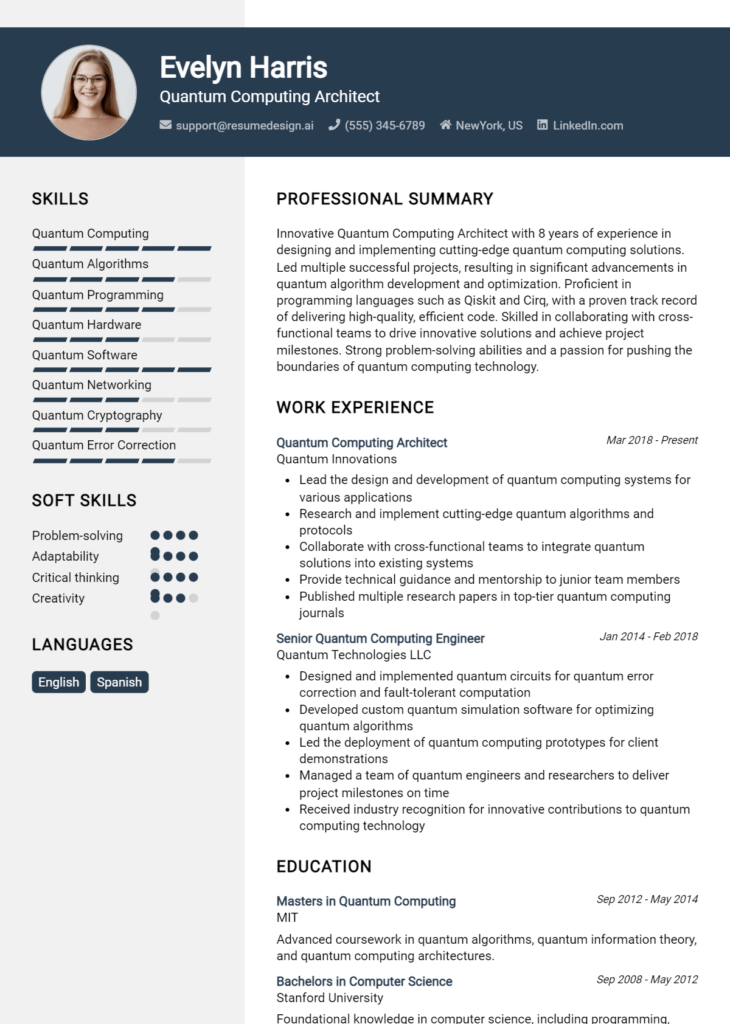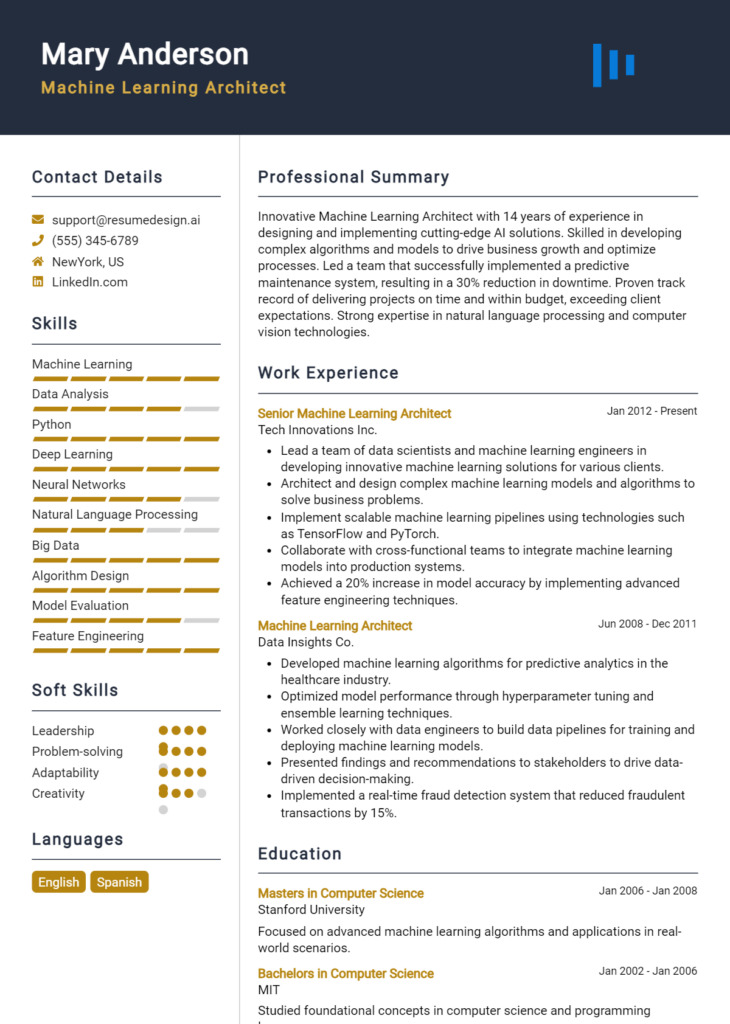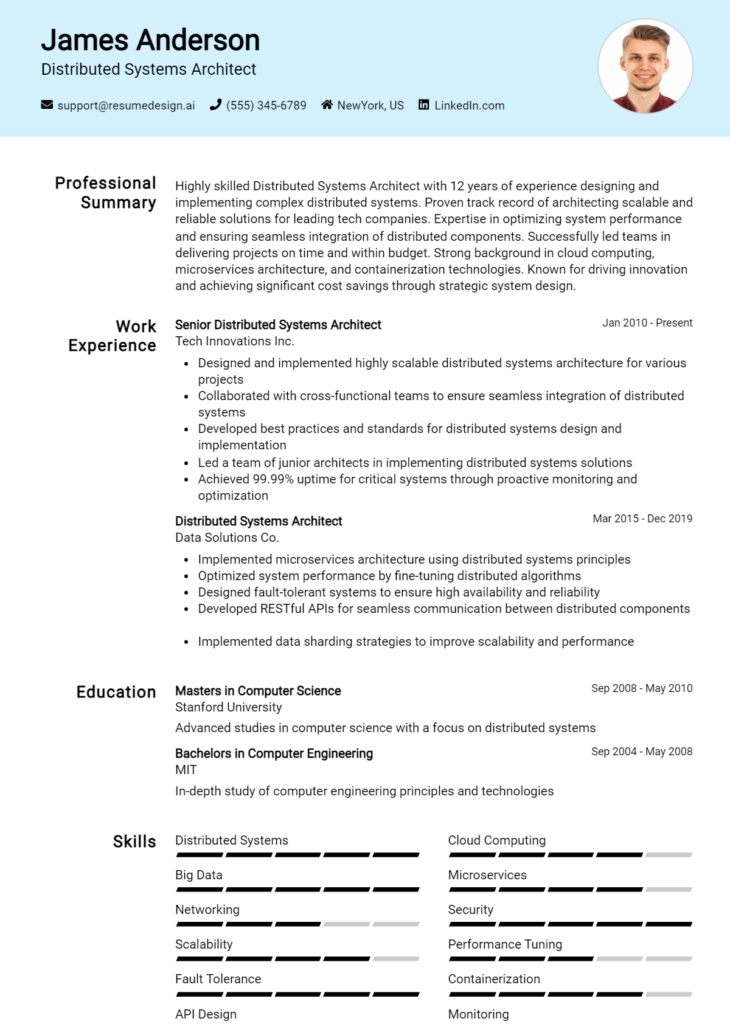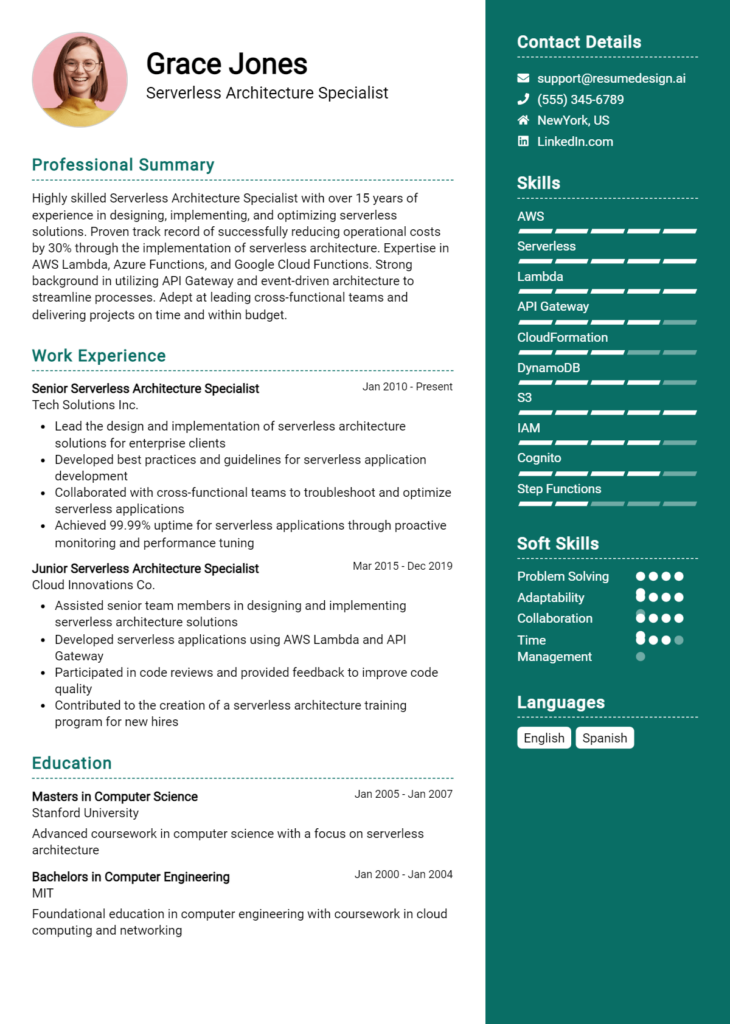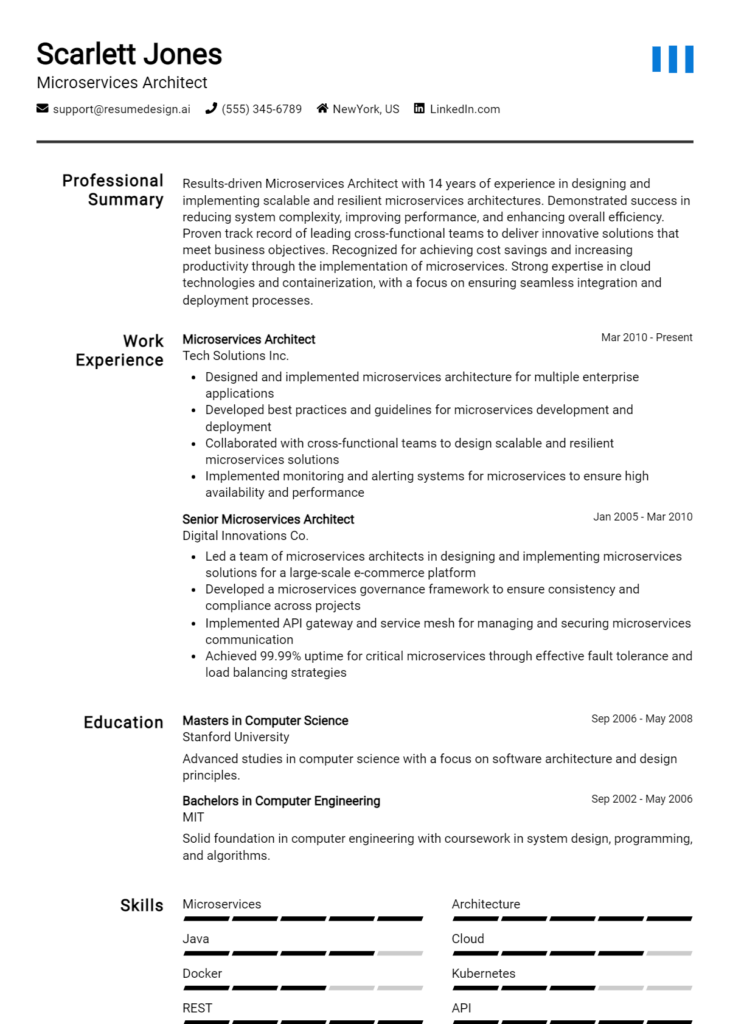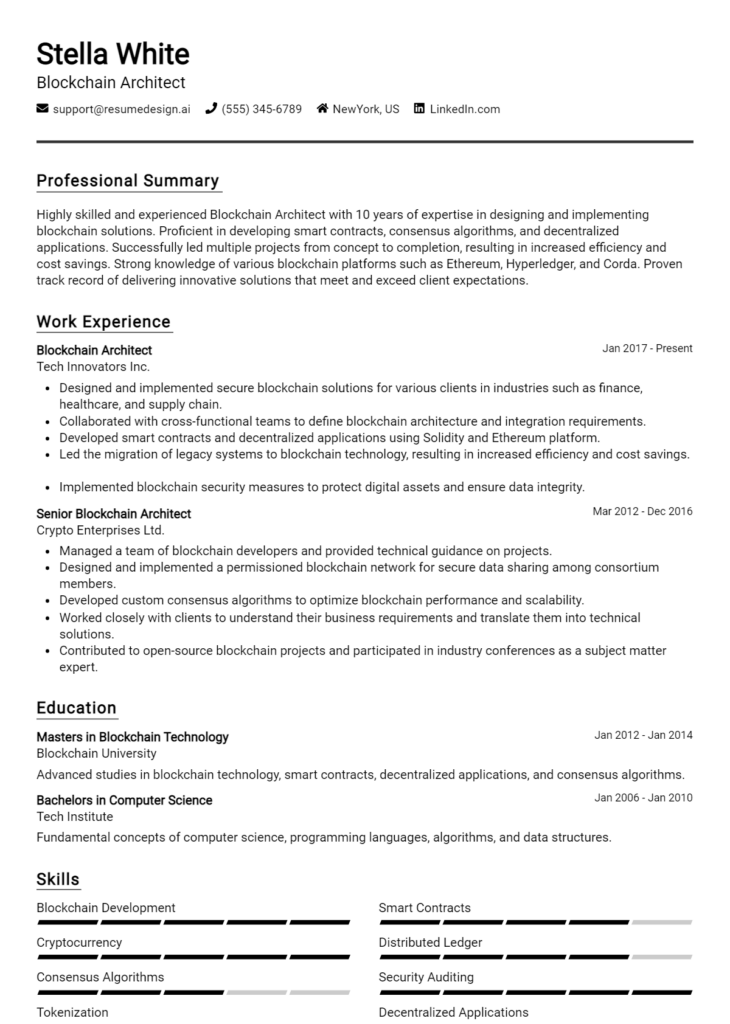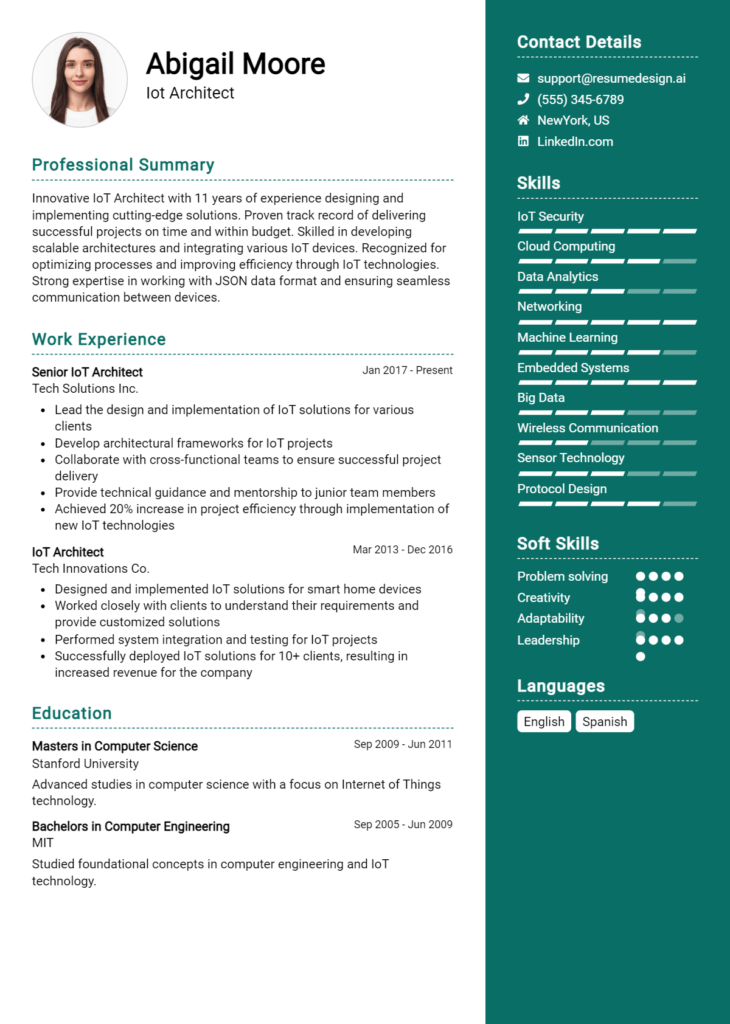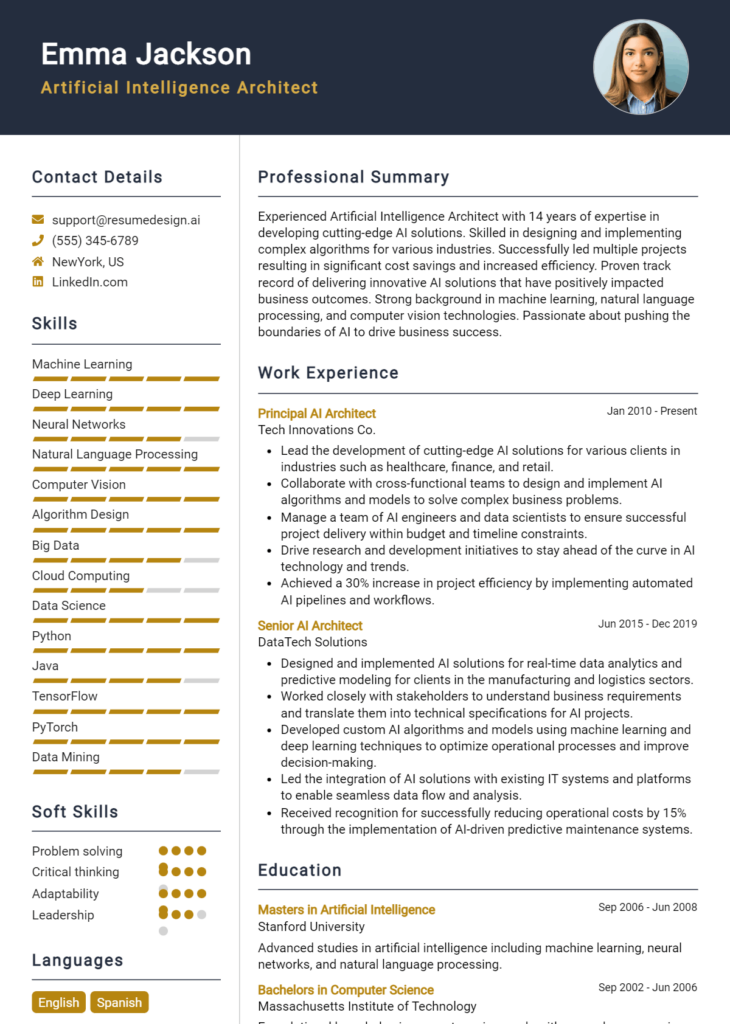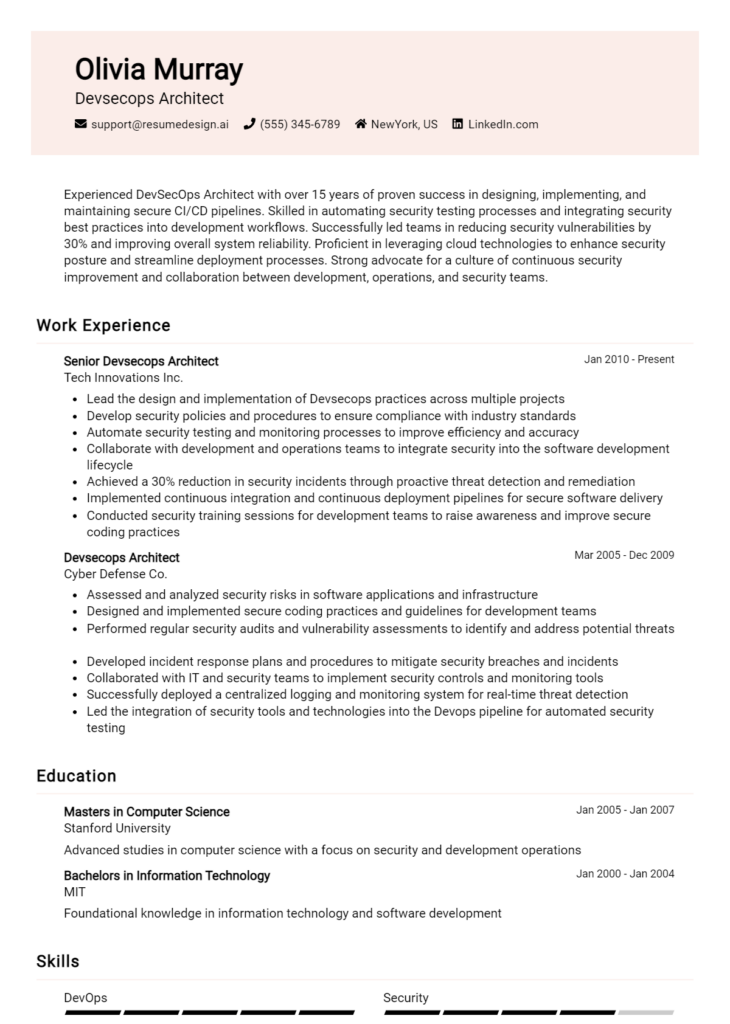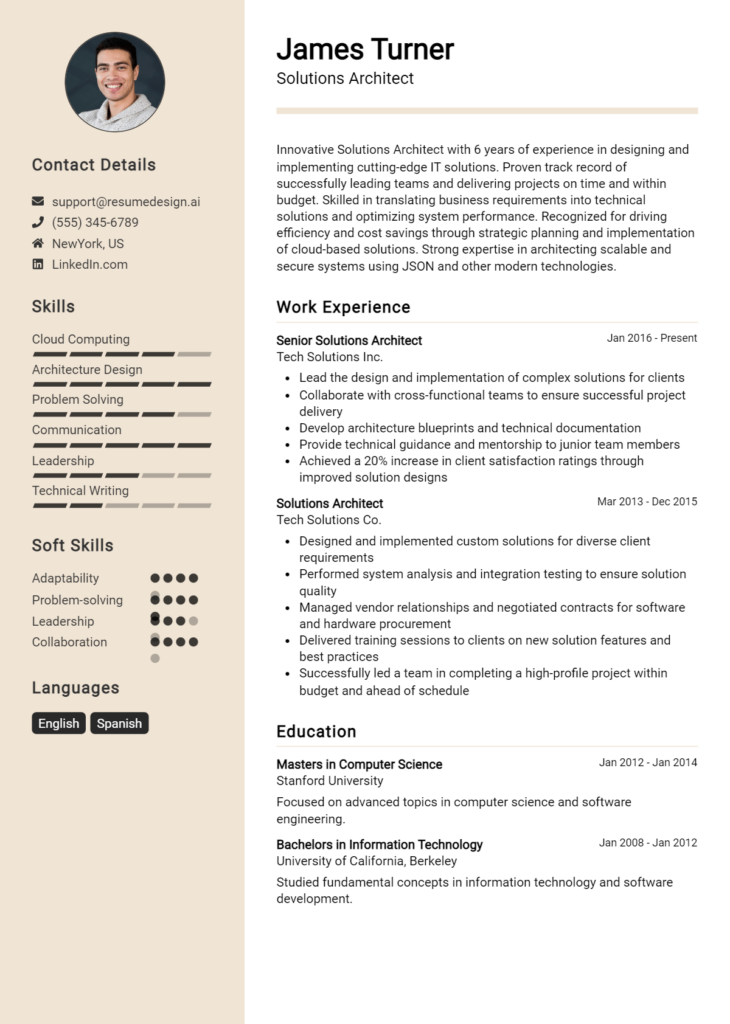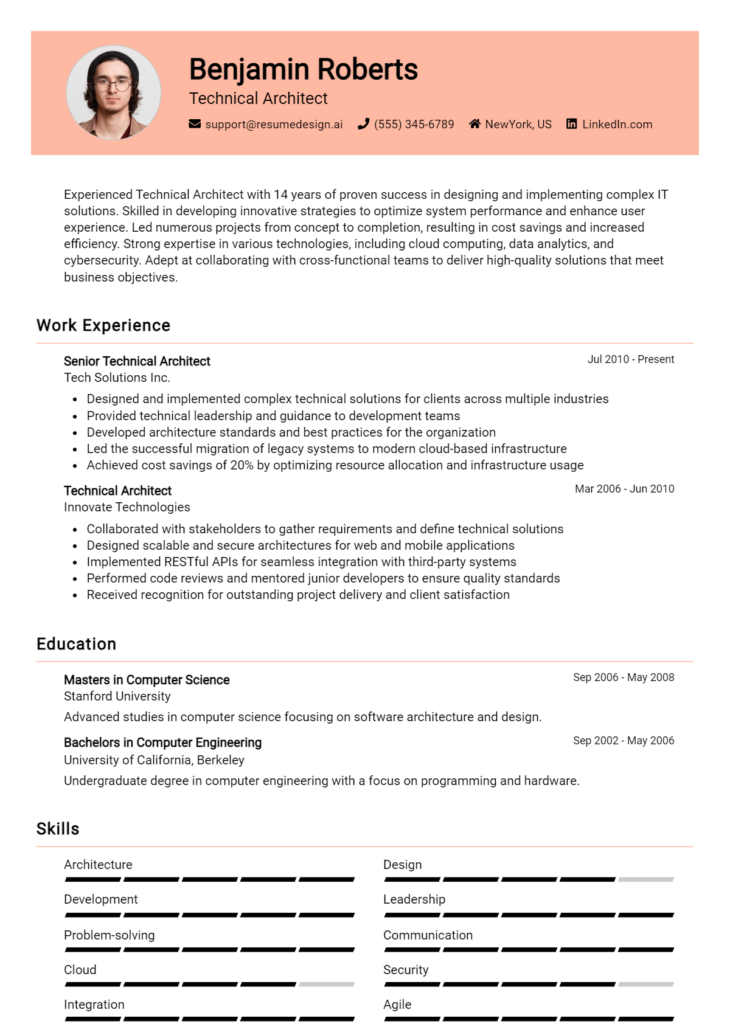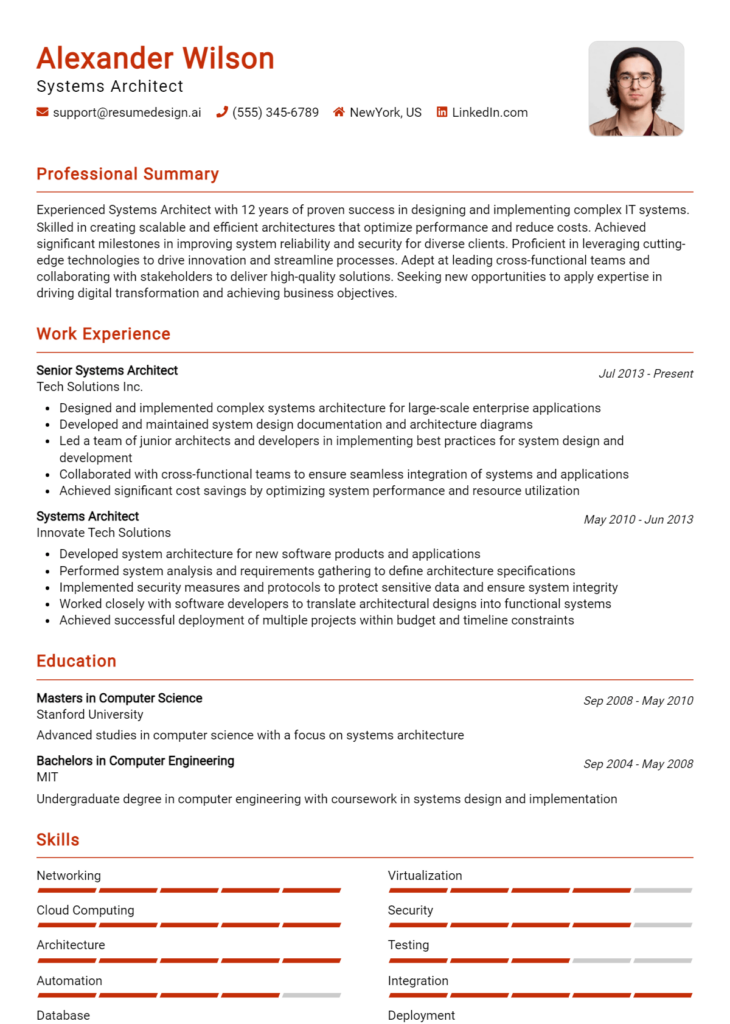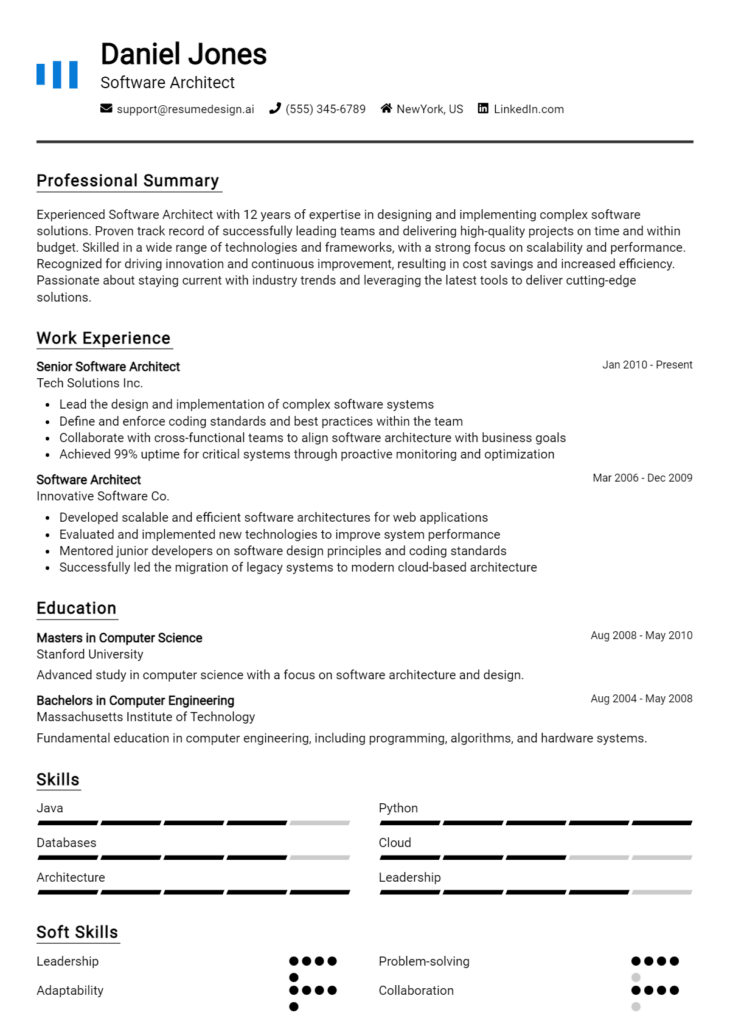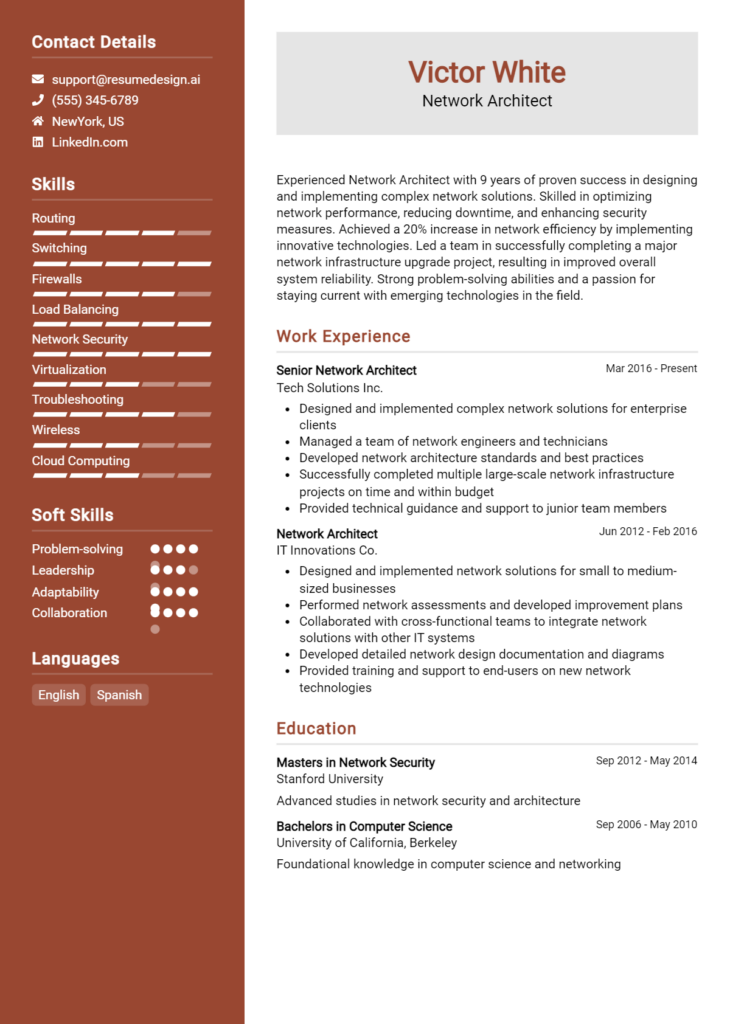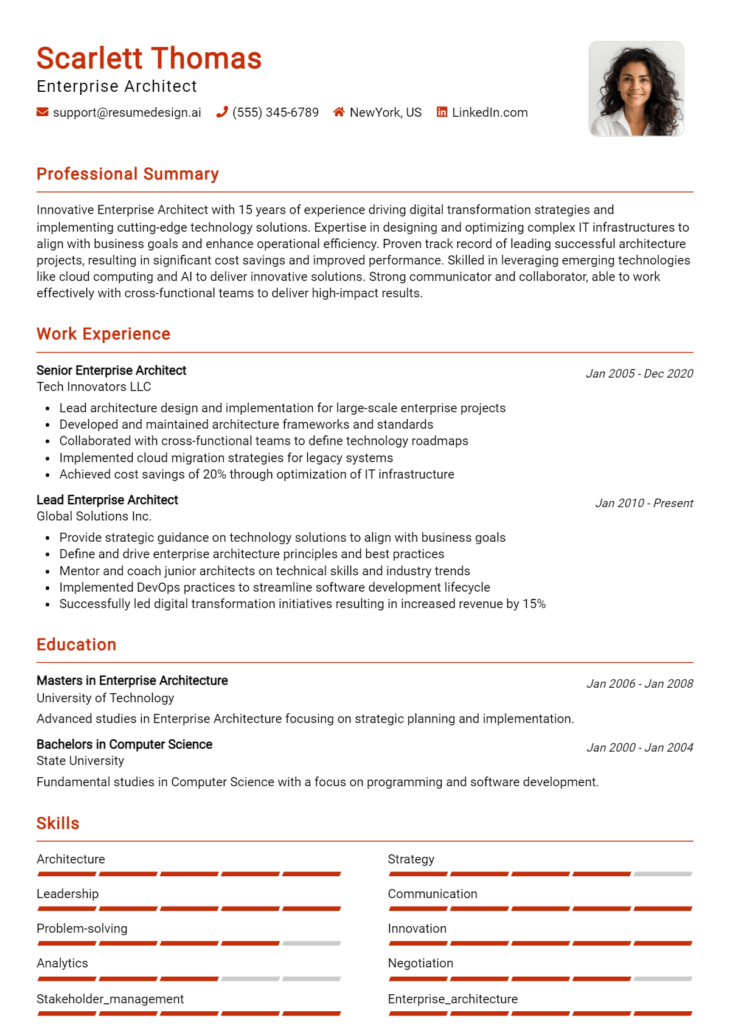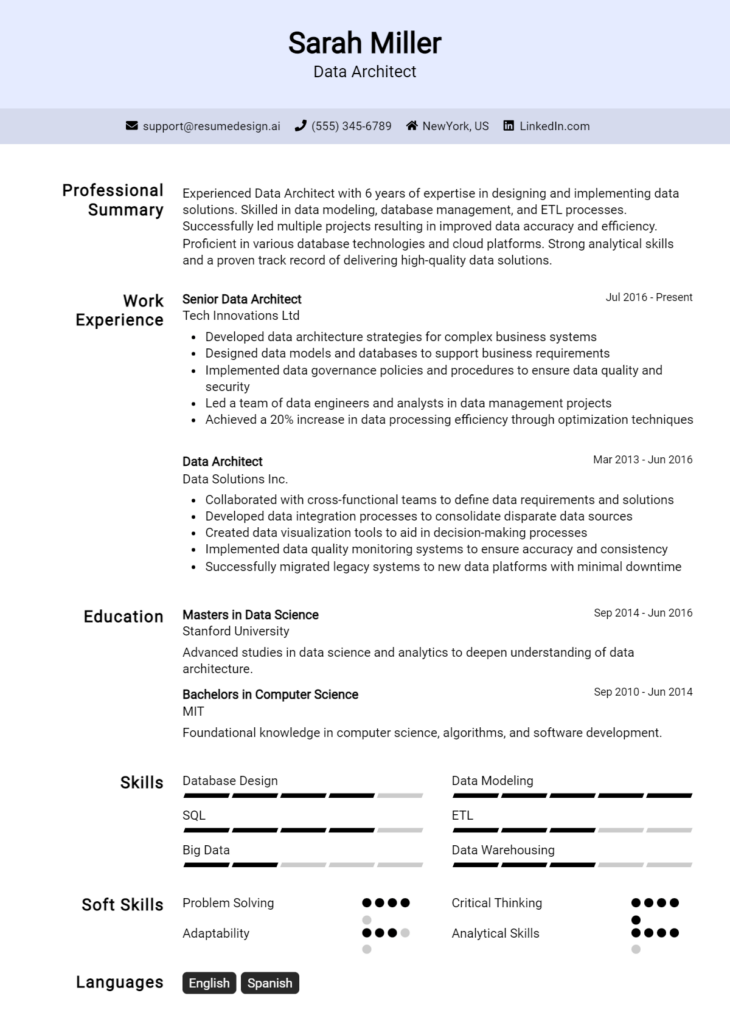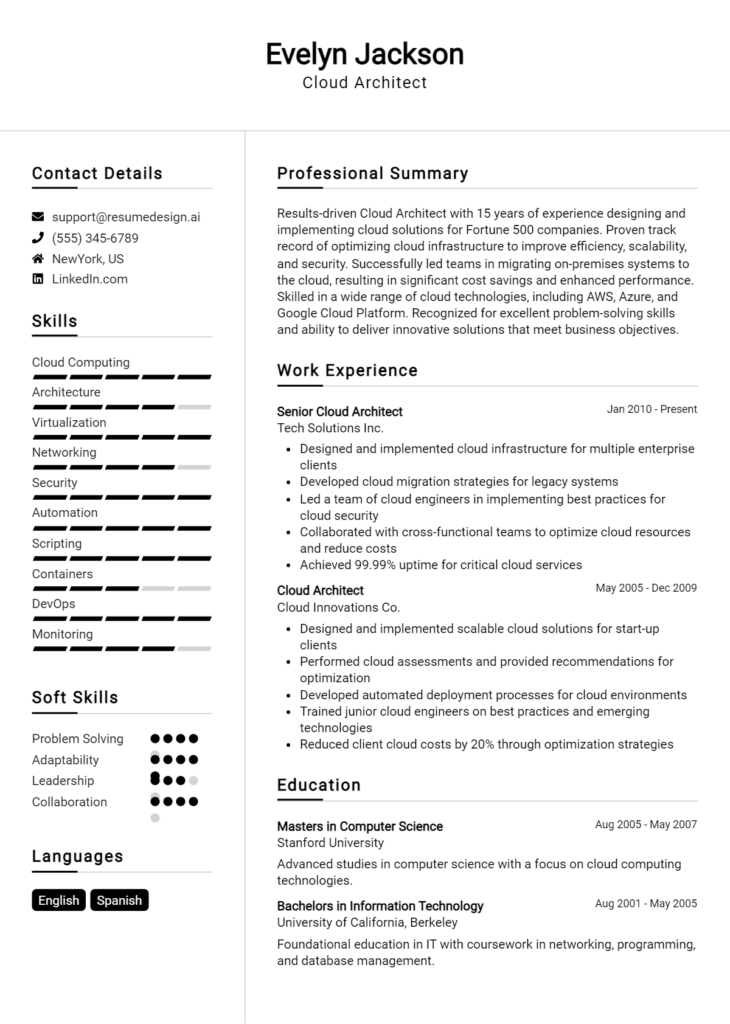Cybersecurity Architect Core Responsibilities
A Cybersecurity Architect plays a vital role in safeguarding an organization's information systems by designing robust security frameworks that integrate seamlessly across various departments. This position requires a blend of technical expertise, operational insight, and strong problem-solving skills to identify vulnerabilities and implement effective solutions. By collaborating with IT, compliance, and risk management teams, a Cybersecurity Architect helps achieve overarching organizational goals. A well-structured resume can effectively highlight these qualifications, showcasing the candidate's ability to enhance security posture and drive business success.
Common Responsibilities Listed on Cybersecurity Architect Resume
- Designing and implementing secure network architectures.
- Conducting risk assessments and security audits.
- Developing security policies and procedures.
- Collaborating with IT teams to ensure security measures are integrated.
- Conducting security training and awareness programs.
- Evaluating and selecting security technologies and tools.
- Monitoring security incidents and responding to breaches.
- Ensuring compliance with industry regulations and standards.
- Performing threat modeling and vulnerability assessments.
- Providing guidance on secure software development practices.
- Engaging with stakeholders to communicate security strategies.
High-Level Resume Tips for Cybersecurity Architect Professionals
In the competitive landscape of cybersecurity, a well-crafted resume is paramount for Cybersecurity Architect professionals aiming to make a lasting impression on potential employers. Your resume often serves as the first point of contact between you and the hiring manager, making it crucial to convey not only your technical skills but also your achievements and professional journey. A strong resume should reflect your expertise in designing secure systems, your understanding of risk management, and your ability to lead security initiatives. This guide will provide practical and actionable resume tips specifically tailored for Cybersecurity Architect professionals, ensuring that your application stands out in a crowded field.
Top Resume Tips for Cybersecurity Architect Professionals
- Tailor your resume to the specific job description by using relevant keywords and phrases that match the requirements of the position.
- Highlight your relevant experience in cybersecurity architecture, including specific projects and the technologies used.
- Quantify your achievements with metrics, such as reducing security incidents by a certain percentage or successfully implementing a security framework that protects assets worth millions.
- Showcase your proficiency with industry-specific tools and technologies, such as firewalls, intrusion detection systems, and risk assessment methodologies.
- Include relevant certifications, such as CISSP, CISM, or CCSP, to demonstrate your commitment to professional development and expertise in the field.
- Emphasize your ability to collaborate with cross-functional teams and communicate complex security concepts to non-technical stakeholders.
- Detail your experience with compliance standards and regulations, such as GDPR, HIPAA, or PCI-DSS, to showcase your understanding of necessary legal frameworks.
- Utilize a clean, professional layout and format that enhances readability, ensuring that your key information stands out.
- Incorporate a summary statement that encapsulates your experience, skills, and career goals, making it easier for employers to see your fit for the role.
By implementing these tips, Cybersecurity Architect professionals can significantly enhance their resumes, increasing their chances of landing a job in this dynamic and essential field. A well-structured resume not only showcases your qualifications but also reflects your professionalism and dedication to cybersecurity, setting you apart from the competition.
Why Resume Headlines & Titles are Important for Cybersecurity Architect
In the competitive field of cybersecurity, a Cybersecurity Architect plays a pivotal role in designing and implementing secure systems that protect sensitive information from threats. As such, crafting an effective resume headline or title is crucial for candidates seeking to make a strong first impression on hiring managers. A well-crafted headline serves as an immediate attention-grabber, summarizing a candidate's key qualifications and expertise in just a few impactful words. This concise statement should be relevant to the job being applied for, encapsulating the essence of the candidate’s skills and experiences while ensuring it resonates with the specific requirements of the role.
Best Practices for Crafting Resume Headlines for Cybersecurity Architect
- Keep it concise: Aim for a headline that is brief yet informative, ideally one to two lines long.
- Be role-specific: Tailor your headline to reflect the specific position you are applying for, highlighting relevant skills.
- Use powerful keywords: Incorporate industry-specific terminology and keywords that align with the job description.
- Highlight key achievements: Consider including a notable accomplishment to demonstrate your impact in previous roles.
- Showcase certifications: If applicable, mention relevant certifications or qualifications that set you apart.
- Avoid jargon: Ensure the language is clear and accessible, avoiding overly technical terms that may confuse the reader.
- Focus on value: Communicate the value you bring to the organization rather than simply listing job titles.
- Maintain professionalism: Ensure the tone of the headline reflects a professional image suitable for the cybersecurity field.
Example Resume Headlines for Cybersecurity Architect
Strong Resume Headlines
“Experienced Cybersecurity Architect Specializing in Cloud Security Solutions”
“Results-Driven Cybersecurity Architect with 10+ Years in Threat Assessment and Risk Management”
“Certified Information Systems Security Professional (CISSP) with Proven Track Record in System Design and Implementation”
Weak Resume Headlines
“Cybersecurity Professional”
“IT Specialist Looking for Work”
Strong headlines are effective because they provide specific information about the candidate’s expertise, accomplishments, and qualifications, allowing hiring managers to quickly grasp their suitability for the role. In contrast, weak headlines often lack specificity and fail to convey the candidate's unique strengths, making them forgettable and less impactful. A compelling headline can set the tone for the entire resume, drawing the reader in and encouraging them to learn more about the candidate's capabilities.
Writing an Exceptional Cybersecurity Architect Resume Summary
A well-crafted resume summary is crucial for a Cybersecurity Architect, as it serves as the first impression for hiring managers who sift through numerous applications. This concise overview quickly showcases a candidate's key skills, relevant experience, and notable accomplishments, allowing them to stand out in a competitive job market. An impactful summary not only highlights the candidate's expertise in cybersecurity but also aligns with the specific requirements of the job they are applying for. By being tailored, concise, and engaging, a strong resume summary can significantly increase the chances of capturing the attention of potential employers and securing an interview.
Best Practices for Writing a Cybersecurity Architect Resume Summary
- Quantify achievements to demonstrate impact, such as reducing security breaches by a specific percentage.
- Focus on key skills relevant to the role, such as risk assessment, threat modeling, and security compliance.
- Tailor the summary to match the job description, including keywords and phrases from the posting.
- Keep it concise, ideally between 3-5 sentences, to maintain the reader's attention.
- Highlight certifications or specialized training that are pertinent to the field, such as CISSP or CEH.
- Use strong action verbs to convey confidence and proactivity in your role.
- Avoid jargon that may not be understood by all hiring managers; keep language clear and accessible.
- Emphasize leadership or team collaboration experiences that showcase your ability to work effectively in a group.
Example Cybersecurity Architect Resume Summaries
Strong Resume Summaries
Detail-oriented Cybersecurity Architect with over 8 years of experience in designing robust security infrastructures for Fortune 500 companies. Successfully reduced potential vulnerabilities by 40% through comprehensive risk assessments and proactive threat modeling.
Results-driven Cybersecurity Architect holding a CISSP certification, specializing in cloud security solutions. Led a team that implemented a multi-layered security strategy, reducing security incidents by 30% in the first year.
Innovative Cybersecurity Architect with a proven track record of developing and implementing security frameworks that align with organizational objectives. Achieved compliance with ISO 27001 standards, enhancing data protection protocols and increasing client trust by 25%.
Weak Resume Summaries
Experienced cybersecurity professional looking for a challenging role in a dynamic environment.
Cybersecurity Architect with a general understanding of security protocols and a desire to learn more.
The strong resume summaries are effective because they provide specific measurable outcomes, highlight relevant skills and certifications, and clearly demonstrate the candidate's direct impact on previous employers. In contrast, the weak summaries lack specificity and quantifiable results, making them seem vague and generic. This makes it difficult for hiring managers to gauge the candidate's capabilities and relevance to the role, ultimately diminishing their chances of being noticed in the selection process.
Work Experience Section for Cybersecurity Architect Resume
The work experience section of a Cybersecurity Architect resume is critical for demonstrating a candidate's technical acumen, leadership capabilities, and effectiveness in delivering high-quality cybersecurity solutions. This section serves as a platform for showcasing not only the depth of knowledge in cybersecurity frameworks, tools, and practices but also the ability to manage teams and collaborate with cross-functional stakeholders. By quantifying achievements and aligning past experiences with industry standards, candidates can effectively illustrate their contributions to organizational security and risk management, making a compelling case for their candidacy.
Best Practices for Cybersecurity Architect Work Experience
- Highlight relevant technical skills and tools used in past roles.
- Quantify achievements by using metrics, such as percentage reductions in security breaches or improvements in response times.
- Emphasize leadership roles, including team management and project oversight.
- Showcase collaboration with other departments, such as IT, compliance, and risk management.
- Use action verbs to describe responsibilities and accomplishments.
- Align experiences with industry standards and frameworks, such as NIST, ISO, or CIS.
- Include certifications or training that enhanced skills relevant to the roles listed.
- Tailor your experience to reflect the specific requirements of the job you're applying for.
Example Work Experiences for Cybersecurity Architect
Strong Experiences
- Led a team of 10 cybersecurity professionals to develop and implement an enterprise-wide security architecture that resulted in a 30% reduction in vulnerabilities over one year.
- Designed and executed a comprehensive incident response plan, reducing the average incident recovery time from 48 hours to 12 hours, thereby minimizing potential data loss.
- Collaborated with cross-functional teams to integrate security measures into the software development lifecycle, which improved compliance with industry standards by 40%.
- Managed a budget of $1 million for cybersecurity initiatives, successfully deploying solutions that increased network security and reduced costs by 20% through strategic vendor negotiations.
Weak Experiences
- Assisted in cybersecurity projects and tasks as needed.
- Worked on security measures to improve the company’s overall security.
- Participated in team meetings to discuss cybersecurity strategies.
- Helped maintain security protocols and systems.
The examples listed as strong experiences are considered effective because they quantify achievements, demonstrate clear leadership, and highlight collaboration with measurable outcomes. In contrast, the weak experiences lack specificity and impact, presenting vague descriptions that do not clearly convey the candidate's contributions or successes in their roles. Strong experiences provide clear evidence of skills and accomplishments, while weak experiences fail to engage potential employers or illustrate the candidate's qualifications.
Education and Certifications Section for Cybersecurity Architect Resume
The education and certifications section of a Cybersecurity Architect resume is crucial for demonstrating a candidate's academic foundation and professional qualifications in a highly specialized field. This section not only showcases relevant degrees and industry-recognized certifications but also reflects the candidate's commitment to continuous learning and staying updated with the evolving cybersecurity landscape. By providing details on relevant coursework, certifications, and specialized training, candidates can significantly enhance their credibility and demonstrate their alignment with the specific requirements of the Cybersecurity Architect role.
Best Practices for Cybersecurity Architect Education and Certifications
- Include degrees from accredited institutions that are relevant to cybersecurity, information technology, or computer science.
- List industry-recognized certifications such as CISSP, CISM, CEH, or CCSP to highlight your qualifications.
- Provide details on relevant coursework that showcases your knowledge of security architecture, risk management, and networking.
- Emphasize any specialized training or workshops that pertain to current cybersecurity trends and technologies.
- Prioritize certifications that are recent or regularly updated to demonstrate your commitment to ongoing education.
- Use specific dates to indicate when degrees and certifications were obtained to present a clear timeline of your qualifications.
- Consider including honors or distinctions received during your academic career that relate to cybersecurity.
- Tailor this section to align with the job description, emphasizing the most relevant qualifications for the position you are applying for.
Example Education and Certifications for Cybersecurity Architect
Strong Examples
- M.S. in Cybersecurity, University of XYZ, 2021
- CISSP (Certified Information Systems Security Professional), 2022
- Risk Management Framework (RMF) Training, 2020
- B.S. in Computer Science, University of ABC, 2019
Weak Examples
- B.A. in History, University of DEF, 2010
- CompTIA A+ Certification, 2015
- Outdated Security+ Certification, 2016
- Non-relevant online course in Digital Marketing, 2022
The strong examples are considered effective because they reflect relevant degrees and certifications that align closely with the Cybersecurity Architect role, showcasing a solid foundation in both education and industry-recognized credentials. In contrast, the weak examples illustrate qualifications that are either outdated or unrelated to cybersecurity, which may detract from the candidate's suitability for the position and fail to convey the necessary expertise in the field.
Top Skills & Keywords for Cybersecurity Architect Resume
In the rapidly evolving field of cybersecurity, a well-crafted resume is essential for showcasing your qualifications as a Cybersecurity Architect. The skills you highlight can significantly influence the perception of your expertise and capabilities. A strong resume not only reflects your technical acumen but also your ability to collaborate, innovate, and problem-solve in a complex environment. Tailoring your skills to align with industry standards and job requirements will help demonstrate your value to potential employers, making it crucial to include both hard and soft skills that resonate with the demands of the role.
Top Hard & Soft Skills for Cybersecurity Architect
Soft Skills
- Strong analytical thinking
- Excellent communication skills
- Team collaboration
- Problem-solving ability
- Adaptability to change
- Leadership qualities
- Time management
- Attention to detail
- Strategic planning
- Conflict resolution
Hard Skills
- Knowledge of security frameworks (e.g., NIST, ISO 27001)
- Proficiency in network security protocols
- Experience with firewalls and intrusion detection systems
- Expertise in risk assessment and management
- Familiarity with encryption technologies
- Understanding of cloud security architectures
- Knowledge of regulatory compliance (e.g., GDPR, HIPAA)
- Proficient in vulnerability assessment tools
- Experience with incident response and management
- Familiarity with programming languages (e.g., Python, Java)
To deepen your understanding of how to effectively incorporate these skills into your resume, check out skills and ensure your work experience aligns with these key competencies.
Stand Out with a Winning Cybersecurity Architect Cover Letter
I am writing to express my interest in the Cybersecurity Architect position at [Company Name], as advertised on [Job Board/Company Website]. With over [X years] of experience in designing and implementing robust cybersecurity frameworks, I am excited about the opportunity to contribute to your team. My extensive background in risk assessment, threat modeling, and security architecture, combined with my passion for staying ahead of emerging threats, positions me as a strong candidate to help fortify [Company Name]'s security posture.
In my previous role at [Previous Company Name], I successfully led a team to develop a comprehensive security architecture that reduced vulnerabilities by [X%]. By employing advanced security technologies and best practices, we ensured compliance with industry regulations and enhanced overall data protection. My ability to collaborate across departments, including IT and compliance teams, allowed us to implement security measures that were both effective and conducive to business operations. I am particularly proud of my contribution to a critical project that involved the integration of cloud security solutions, which not only improved our security framework but also optimized operational efficiency.
I am particularly drawn to [Company Name] because of its commitment to innovation and excellence in cybersecurity. I admire your proactive approach to cybersecurity challenges and your focus on continuous improvement. I am eager to bring my skills in designing scalable security architectures and my knowledge of the latest cybersecurity trends to your esteemed organization. Together, we can ensure that [Company Name] remains a leader in the industry, effectively safeguarding its assets and reputation.
Thank you for considering my application. I look forward to the opportunity to discuss how my experience and vision align with the goals of [Company Name]. I am excited about the possibility of contributing to your team and supporting your mission to create a secure digital environment.
Common Mistakes to Avoid in a Cybersecurity Architect Resume
When applying for a position as a Cybersecurity Architect, crafting a compelling resume is crucial to stand out in a competitive job market. However, many candidates make common mistakes that can undermine their chances of landing an interview. By avoiding these pitfalls, you can enhance your resume's effectiveness and better showcase your skills and experience in the field of cybersecurity.
Lack of Specificity: Failing to provide specific details about your experience can make your resume generic. Highlight particular projects, technologies, and methodologies you've worked with to demonstrate your expertise.
Ignoring Keywords: Many companies use Applicant Tracking Systems (ATS) to screen resumes. Not including relevant keywords from the job description can result in your resume being overlooked.
Overloading with Technical Jargon: While it’s important to showcase your technical skills, excessive jargon can alienate hiring managers. Strive for a balance between technical terminology and clear, concise language.
Neglecting Soft Skills: Cybersecurity Architects need strong communication and leadership skills. Omitting these from your resume may give the impression that you lack the necessary interpersonal abilities to work effectively with teams.
Failing to Quantify Achievements: Simply listing responsibilities doesn’t convey your impact. Use metrics to quantify your achievements, such as percentage improvements in security posture or reductions in incident response times.
Not Tailoring Your Resume: Sending the same resume for every application can be detrimental. Tailor your resume to highlight the most relevant experiences and skills for each specific job.
Inconsistent Formatting: A cluttered or inconsistent format can distract from your qualifications. Ensure your resume is well-organized, with clear headings and uniform font styles and sizes.
Omitting Certifications and Training: Cybersecurity is a rapidly evolving field, and certifications can set you apart. Ensure you list relevant certifications, such as CISSP, CISM, or Azure Security Architect Expert, to demonstrate your commitment to professional development.
Conclusion
As a Cybersecurity Architect, your role is pivotal in safeguarding an organization's digital infrastructure. Throughout the article, we've explored the essential skills and qualifications necessary for success in this field, including expertise in risk assessment, knowledge of security frameworks, and the ability to design robust security architectures. We also discussed the importance of staying updated with the latest cybersecurity trends and technologies, as well as the need for effective communication and collaboration with various stakeholders within an organization.
In conclusion, as you reflect on your career and seek new opportunities, it's crucial to ensure that your Cybersecurity Architect resume effectively showcases your skills and experiences. Take the time to review and refine your resume to highlight your accomplishments and align it with the requirements of the roles you are targeting.
To assist you in this process, consider utilizing valuable resources such as resume templates, which can help you structure your resume professionally. Additionally, you might find a resume builder useful for creating a customized resume that stands out. Don't forget to check out resume examples to gain inspiration and insight into how to effectively present your qualifications. Lastly, a well-crafted cover letter template can complement your resume and enhance your job application.
Take action today—review your Cybersecurity Architect resume and leverage these tools to ensure it reflects your expertise and sets you apart in the competitive job market.

